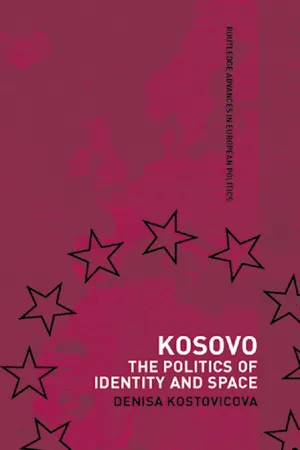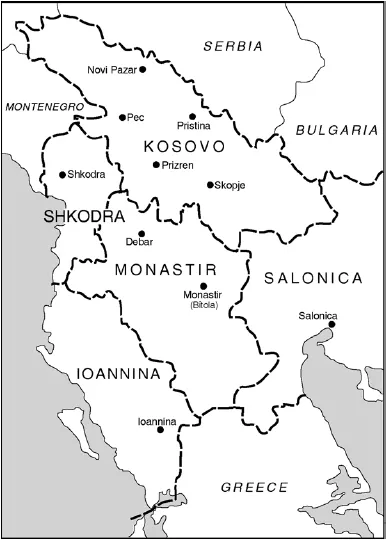![]()
1 Albanian educational battles
From the Ottomans to the Communists
The struggle for Albanian-language education in the Ottoman Empire became a chief promoter of nascent Albanian national identity in the late nineteenth and early twentieth centuries. The quest for Albanian schools also became the rallying point of all Albanians under Ottoman rule, superseding their religious division into Muslims, both of Suni and Bektashi extraction, Orthodox or Catholic Christians, the cultural divide into northern Gegs and southern Tosks with their respective dialects, and the separation into several administrative units, vilayets, shown on Map 1.1. In the process, a symbolic equality was established between national school and national state. Albanians’ movement for national education and for national liberation fed off each other, eventually becoming one. The Albanian-language school became a reality after the creation of an independent Albanian state in 1912. However, Albanians in Kosovo were incorporated first into Serbia and then the inter-war Yugoslavia, continuing the battle for national schooling. In Kosovo, the pattern of domination of one national group over the other was also reflected in education. This pattern was broken, although not completely, in the Communist period. Education in the mother tongue became available to all citizens of Kosovo. Yet, it fell short of being a national education. Rather, it was education in and for the officially sanctioned ideological outlook, captured by the slogan ‘brotherhood and unity’. By attempting to simultaneously encourage and constrain the expression of nationhood, it undermined its own mission. The education system emerged as a focal point of the Kosovo Albanians’ national struggle and resistance in Communist Yugoslavia. This background chapter examines the Albanians’ efforts to establish Albanian-language education while under Ottoman rule. It then explores the Kosovo Albanian educational experience in Yugoslavia, including both the pre-Communist and Communist period.
Map 1.1 The Ottoman vilayets at the turn of the twentieth century.
Bonds of nationhood: Albanian alphabet and Albanian school
The prospects of the loss of Albanian-populated territories to Orthodox Slavs following the San Stefano Treaty (1878) after Russia’s defeat of the Ottomans precipitated the first truly Albanian rebellion.1 Unlike the previous insurrections, fuelled by the defence of local privileges, this one had a national hue. Established the same year, the League of Prizren became the military-political motor of the Albanian national movement,2 whose aim evolved from the defence of Albanian territories, by way of the territorial autonomy of the unified Albanian vilayets in the Ottoman state, to eventual Albanian statehood. The League’s establishment also launched the Albanian cultural revival with its emphasis on the Albanian language and school.3
The military defeat of the Prizren League in 1881 shifted the focus to a cultural engagement:4 the cultural Rilindja meaning Rebirth.5 It was marked by accelerated cultural and symbolic labour with explicitly nationalist overtones. The language came to occupy the central place in the construction of Albanian national identity, driven by the demand for secular Albanian schooling articulated by the Prizren League. The early nineteenth-century pioneers of Albanian nation were, in the main, resident abroad. These nationalists in the diaspora had argued that a national political struggle required the prior enlightenment of the people through language and education. It was only with the San Stefano Treaty (1878) and its threatened loss of Albanian-inhabited territory to Albanians’ neighbours, that these ideas began to resonate in the lands where Albanians lived in the Balkans.6
The cultural revival was promoted by the concerted activities of the Albanian cultural-educational-literary societies. The first, called The Society for the Printing of Albanian Writings, established in Istanbul in 1879 under the guidance of Sami and Naim Frashëri, the brothers of the League’s founder Abdyl, aimed to further the national struggle by publishing in the Albanian language and helping support the founding of Albanian schools.7 Embracing the same goal, cultural societies mushroomed in Romania, Bulgaria, Egypt and the United States (US), as Albanian émigrés seized on their freedom of action abroad. There ensued a prolific publishing activity as ever growing numbers of Albanian primers, dictionaries, books, reviews and journals came off the presses and found their way into Albanian-populated lands in the Balkans.8 Nationalist writing was initiated by Italo-Albanians, who had fled across the Adriatic following the Ottoman conquest of the Balkans.9
However, Albanians still lacked a standardized alphabet. Some writers used Turkish or Arabic, others Cyrillic Greek, and yet others Latin, or a combination of Greek and Latin letters.10 They were promoted by separate societies. Even individuals took to launching their own alphabets.11 The proliferation of alphabets was incisively ridiculed by an Albanian national poet:
[But] again poor Albania
by them will be divided into many chunks and pieces
as there are letters from A to Z.12
Importantly, scripts based on foreign alphabets – Arabic, Latin and Greek – reflected and offset religious differences among Albanian Muslims, Catholics and Orthodox.13 The multitude of alphabets thwarted efforts to establish a uniform national school.14
Early attempts to standardize the alphabet in the 1860s had failed.15 The process got under way at the turn of the century. The Congress of Monastir in 1908, also known as the Alphabet Congress,16 brought together Albanians from all four Albanian vilayets and the diaspora, Gegs and Tosks, Christians and Muslims.17 It declared the Latin alphabet the national script of Albanians, but maintained two variants.18 However, the Latin script, symbolizing the break with the Ottomans, also elicited the staunch opposition from Kosovo Albanians who held on to the script of the Koran,19 and demanded the sacred Arabic alphabet.20 The nationalist defenders of the Latin alphabet responded in equal measure, asserting that the alphabet was above religion.21 Nationalist ranks were multi-confessional, though Muslim support came mainly from the south.22 The Congress of Diber in 1909, organized by the Young Turks, permitted the use of both Albanian and Arabic letters according to one’s preference.23 Responding to this setback, Albanian nationalists endorsed ‘the only alphabet of the people’, which was purely Latin, at the Second Congress of Monastir in 1910.24
Language knitted Albanian inner unity and reinforced an Albanian identity distinct from the Ottomans, and their Slav neighbours. The unified alphabet was the first concrete expression of Albanian nationhood.25 The quest for Albanian schooling gave impetus to the unification of the alphabet, while simultaneously attracting greater popular support as the battle for the Latin alphabet unfolded. Albanians’ confessional differences were to be tamed in the classrooms with Albanian as the language of instruction.
Starting in the 1830s, the Ottomans introduced a series of groundbreaking reforms, allowing the Empire’s ethnic communities to use the vernacular in their scholastic and religious institutions.26 None of these reforms benefited the Albanians. The Ottomans continued to class them on the basis of faith rather than ethnicity. Therefore, Turkish schools were available for Albanian Muslims, and Greek, Serbian or Bulgarian schools for Albanian Orthodox. Albanian Catholics were privileged compared with their co-ethnics. Jesuits and Franciscans opened schools in the north where Albanian was taught, seizing on the rights that Austria had obtained from the Porte. Additionally, the Catholics benefited from Austro-Italian rivalry. Countervailing Austria’s influence, Italy offered Albanian in schools it set up in Catholic areas.27
The proscription of Albanian in schools was intended to forestall any ethnicity-based homogenization among the Albanians.28 But, the Ottoman policy backfired, lending urgency to the demand for the Albanian school articulated by the Prizren League. Ironically, education in foreign schools created an Albanian political and intellectual elite: the most ardent advocates of national education and most vocal critics of the Ottomans’ policy.29 They denounced it for preventing the rise of Albanian national feelings, as well as encouraging Albanians’ divisions along religious lines.30 Foreign schools were also seen as a Trojan horse for territorial claims on their lands by the powers that established them.31
Consequently, the Albanian national school emerged as the only salvation to what nationalists warned was an imperilled Albanian national identity, unity and territory.32 The loss of language in foreign schools was equated by them to the loss of nation.33 An Albanian national poet called for secular education in his verses:
Friends take a strong oath,
not in a church or a mosque,
but in a lay school.34
Meanwhile, the cultural revival initiated by the Prizren League was having an impact on the ground. Albanian publications commanded a growing readership in the homeland owing to a resort to a number of secret strategies. The writing and reading of Albanian spread illegally as secret schools took the place of proscribed Albanian schools. Clandestine classes were set up in grocers’ shops and private homes, in country inns and in the shadows of oak trees. The first Albanian libraries of Albanian primers, books, textbooks, newspapers and other patriotic publications smuggled into Albanian-inhabited lands were secret as well.35 The Albanian language stealthily entered foreign schools as Albanian teachers in Greek and Turkish schools gave secret classes in Albanian.36
The significance of Albanians’ religious divisions diminished as the battle for Albanian education unfolded. The turning point came with the opening of the school in Korca in 1887, after the Albanian nationalists obtained permission from the Porte. It was the Albanians’ first national school, with education in the Albanian language from Albanian textbooks printed abroad. It was situated in a private house, a gift from an Albanian patriot living in Bucharest. He wrote: ‘My house should be emptied and turned into an Albanian school.’37 Students flocked to their first national school, abandoning the foreign schools they had hitherto attended.38 Several similar schools were opened, but, with few exceptions, like the Qiriazi national girls’ school, were short-lived.39
Secrecy still provided a haven for the advance of Albanian education until the 1908 Young Turk revolution in Istanbul. The proclamation of the constitution by the Young Turks was welcomed with enthusiasm by Albanians who referred to it as ‘Hyriet’ or Freed...

